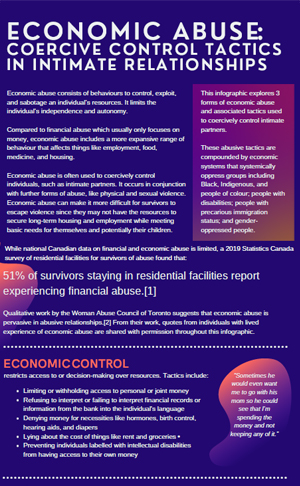Our Work
.
Economic Abuse: Coercive Control Tactics in Intimate Relationships
 View PNG version
View PNG version
View Printable PDF Infographic
This infographic explores 3 forms of economic abuse and associated tactics used to coercively control intimate partners.
These abusive tactics are compounded by economic systems that systemically oppress groups including Black, Indigenous, and people of colour; people with disabilities; people with precarious immigration status; and gender-oppressed people.
Economic abuse consists of behaviours to control, exploit, and sabotage an individual’s resources. It limits the individual’s independence and autonomy.
Compared to financial abuse which usually only focuses on money, economic abuse includes a more expansive range of behaviour that affects things like employment, food, medicine, and housing.
Economic abuse is often used to coercively control individuals, such as intimate partners. It occurs in conjunction with further forms of abuse, like physical and sexual violence. Economic abuse can make it more difficult for survivors to escape violence since they may not have the resources to secure long-term housing and employment while meeting basic needs for themselves and potentially their children.
While national Canadian data on financial and economic abuse is limited, a 2019 Statistics Canada survey of residential facilities for survivors of abuse found that: 51% of survivors staying in residential facilities report experiencing financial abuse.[1]
Qualitative work by the Woman Abuse Council of Toronto suggests that economic abuse is pervasive in abusive relationships.[2] From their work, quotes from individuals with lived experience of economic abuse are shared with permission throughout this infographic.
Economic Control
restricts access to or decision-making over resources. Tactics include:
- Limiting or withholding access to personal or joint money
- Refusing to interpret or failing to interpret financial records or information from the bank into the individual's language
- Denying money for necessities like hormones, birth control, hearing aids, and diapers
- Lying about the cost of things like rent and groceries
- Preventing individuals labelled with intellectual disabilities from having access to their own money
“Sometimes he would even want me to go with his mom so he could see that I’m spending the money and not keeping any of it.”
Economic Exploitation
involves destroying the individual’s financial resources or credit. Tactics include:
- Destroying the home, car, or other possessions of the individual
- Spending large amounts of joint money without consent
- Exploiting memory loss due to traumatic brain injury or dementia to gain money
- Forcing the individual to apply for loans or a line of credit under the threat of further harm
- Pursuing expensive legal proceedings for divorce or child custody
“I had to move from the apartment that I lived in even with him because of having a lack of rent. He jeopardized my housing. I was paying rent but he would just keeping taking money out of it."
Economic Sabotage
inhibits the individual’s ability to gain or maintain work. This form of abuse is exacerbated when the individual works with their partner. Tactics include:
- Hiding required documentation (e.g. gender-affirming identification, proof of legal status in Canada)
- Reporting an individual who engages in sex work to law enforcement or immigration authorities
- Destroying home offices or necessary work equipment
- Stalking the individual at their place of work
- Requesting that personal connections do not hire the individual in contexts of limited employment opportunities (e.g. pressuring the small amount of companies in a rural, remote, or northern region to not hire an individual)
“Even though he wanted my money, he would like lock me, literally lock me in my bedroom and stay at the door and I couldn’t go to work so I ended up losing my job.”
Join the National Taskforce for Women’s Economic Abuse and Injustice in calling for policy change to end economic abuse:
- Expand the National Action Plan to End Gender-Based Violence and the Divorce Act to include economic abuse
- Create a statutory definition of family and gender-based violence that is inclusive of economic abuse
- Mandate Statistics Canada to begin collecting data and conduct studies on economic abuse
- Expand funding for services for survivors of domestic violence and economic abuse
- Recognize November 26 as the National Day of Awareness for Economic Abuse and Survivors of Economic Injustice
Click here to sign a petition calling on the Government of Canada to take action on economic abuse!
The Learning Network produced this resource in collaboration with:
- Woman Abuse Council of Toronto (WomanACT)
- Canadian Center for Women’s Empowerment l Centre canadien pour l'autonomisation des femmes
Credit support for survivors of economic abuse is available by CCFWE and Project Recover, click here to learn more. #HELPUSRISE
[1] Statistics Canada. (2019). Canadian residential facilities for victims of abuse, 2017/2018. Retrieved from https://www150.statcan.gc.ca/n1/en/pub/85-002-x/2019001/article/00007-eng.pdf?st=SKone9ir
[2] Woman Abuse Council of Toronto (WomanACT). (2019). Hidden in the everyday: Financial abuse as a form of intimate partner violence. Retrieved from https://womanact.ca/publications/hidden-in-the-everyday-financial-abuse-as-a-form-of-intimate-partner-violence-in-the-toronto-area/
All our resources are open-access and can be shared (e.g., linked, downloaded and sent) or cited with credit. If you would like to adapt and/or edit, translate, or embed/upload our content on your website/training materials (e.g., Webinar video), please email us at gbvln@uwo.ca so that we can work together to do so.






